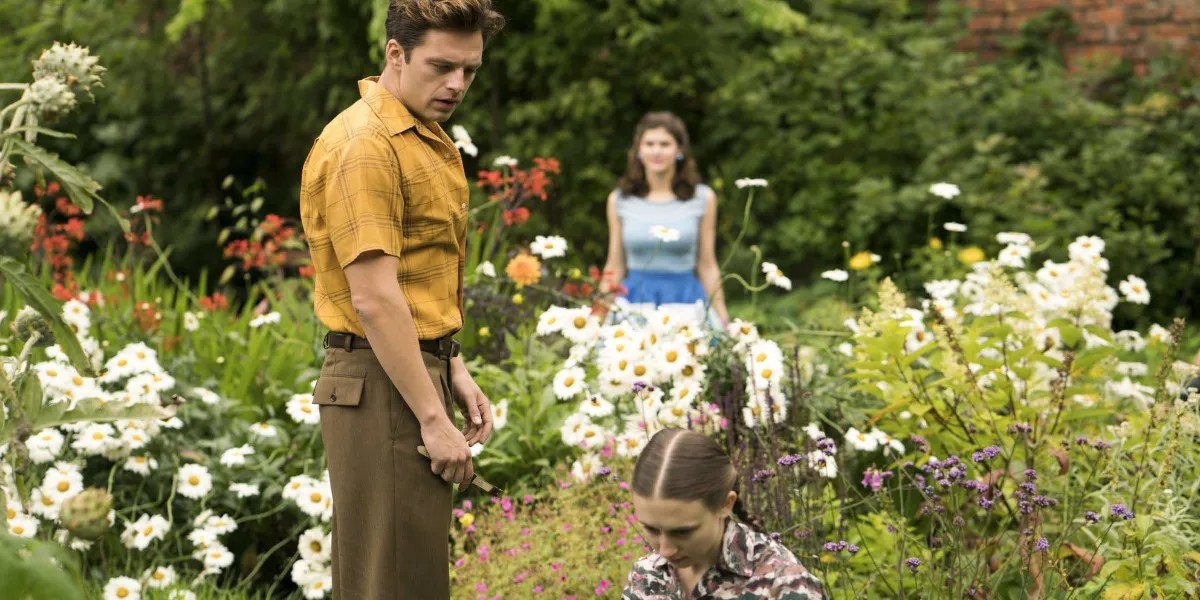The 2018 mystery film, ‘We Have Always Lived In the Castle,’ presents the story of two enigmatic sisters and an outsider who flips their world on its axis. Merricat Blackwood and her older, calmer sister, Constance, live in their family house with their uncle Julian. However, due to an arsenic accident that wiped out the rest of the family six years ago, the entire town shuns the Blackwoods, believing the older sister to be behind the deaths. Consequently, the arrival of their magnetic cousin, Charles, with his uncanny resemblance to their father, brings a respite from the girls’ isolation. Yet, with the man’s eyes on the sisters’ family inheritance, disarray enters the Blackwoods’ lives as an old friend.
Set to an effortlessly Gothic tone, this film thrives on vague mystery and a slow revelation of the madness hidden within. Still, the narrative remains grounded despite its fanciful period setting. For the same reason, viewers may be compelled to grow curious regarding the origins of the Blackwood sisters and if the movie is based on a true story.
We Have Always Lived in the Castle: Shirley Jackson’s Literary Masterpiece
‘We Have Always Lived in The Castle’ is an on-screen adaptation of Shirley Jackson’s eponymous novel, which itself was a work of fiction. As a result, Stacie Passon’s 2018 film is also rendered a fictitious work without any roots in reality, save for the ones it inherits from Jackson’s writing. Although the 1962 novel is fictional in nature, with Jackson fabricating the characters, their setting, and the events that unfold in their lives, the inspirations behind these elements create a rich origin for the story.
One of the chief themes within Jackson’s ‘We Have Always Lived in the Castle’ emerges from the everpresent agoraphobia that the Blackwood sisters’ situation emulates. In fact, Judy Oppenheimer, who wrote a biography on the author’s life, described her ultimate and most beloved novel as “a paean to agoraphobia.” Considering Jackson’s own agoraphobia, which has always been public knowledge, her exceptional ability to convey the same likely stems from her own experiences.
In fact, in September of 1962, the same month the novel saw its publication, Jackson’s acute agoraphobia sent her into a nervous breakdown that resulted in her confinement to her house for about six months. “If I am cured and well and oh glorious alive, then my books should be different,” Jackson wrote in the journal she kept for the two years that it took for her to recover. “Who wants to write about anxiety from a place of safety? Although I suppose I would never be entirely safe since I cannot completely reconstruct my mind.”
Thus, we can conclude that a significant aspect of the story’s theme, which inevitably informs the book’s premise, revolving around a pair of isolated sisters, originates from Jackson’s experience with her specific anxiety disorder. Likewise, many have interpreted the two Blackwood sisters, Constance and Merricat, as complementary pieces of the author’s own personality after Jackson’s assertion that the sisters are “two halves of the same person.”
Jackson’s son, Laurence Jackson Hyman, even spoke about the novel and its connection to his late mother— and said, “I think that my mother really put herself into that book in a way that she may not have in some of the others.” Inversely, according to Ruth Franklin, who penned the award-winning biography, ‘Shirley Jackson: A Rather Haunted Life,’ Constance and Merricat were modeled after Jackson’s daughters, Joanne and Sarah.
Thus, the story possesses many tangible connections to Jackson’s life that served as inspiration for the book’s themes and characters. Nevertheless, only one of these perceived inspirations connects the story to a real-life event: Charles Bravo’s infamous murder case.
Charles Bravo’s Mysterious Death

Even though Jackson never pointedly made any allusions to her novel’s connection to the Charles Bravo Murder, Franklin asserts that the author gained inspiration from the case in crafting the book’s narrative. Bravo was a British lawyer who died a mysterious death in the 1870s. The yet unsolved case achieved a sensationalized reputation among the masses and remained a topic of conversation even in the 1960s when Jackson would have been working on her novel.
Bravo died in at The Priory, now a landmark in Balham, London, where— after the royal physician and other exceptional doctors’ examination— he was found to be dead due to antimony poisoning. Nevertheless, the authorities never came to an explanation of how the deadly poison found its way into Bravo’s system. Most peculiarly, Bravo’s death loomed for three days, wherein the man lay on his deathbed. Yet, he refused to offer any information that could solve the mystery of his own death.
Thus, many speculations emerged, including rumors that pinned the murder on Bravo’s wife, Florence Campbell, heir to her family’s wealth, or their housekeeper, Mrs. Cox. One theory even suggests Bravo died after mistakenly consuming the poison he was using to microdose Campbell. Regardless, the bottom line emerges that Bravo’s murder at a hauntingly gothic estate remains unsolved but plagued with rumors and gossip.
As such, many believe Bravo’s case to have been an inspiration to Jackson. Even so, clear distinctions persist between Bravo’s case and Jackson’s story, rendering the former’s influence minimal within the author’s work. Therefore, ultimately, several aspects of Jackson’s life seem to have served as her muse in the story’s conception. Yet, the events depicted within ‘We Have Always Lived in the Castle’ remain fictional.
Read More: Surviving the Sleepover: Reality or Fiction


